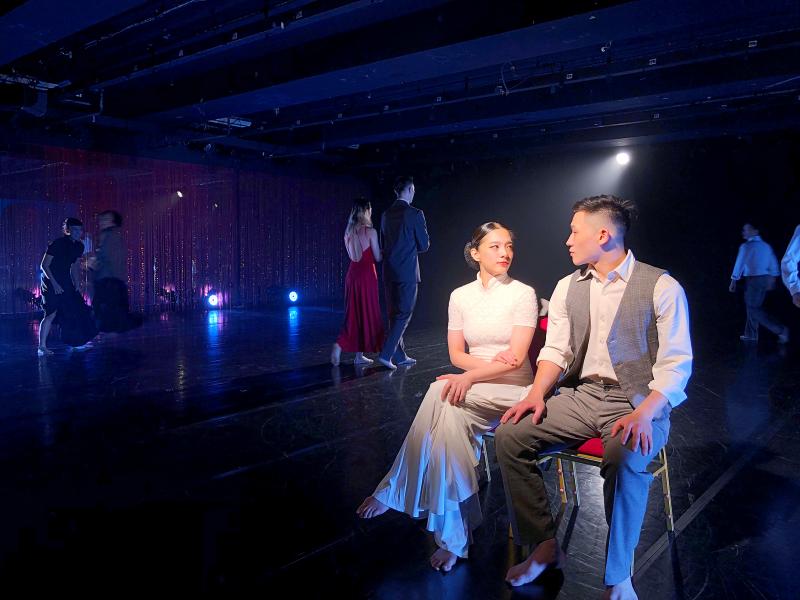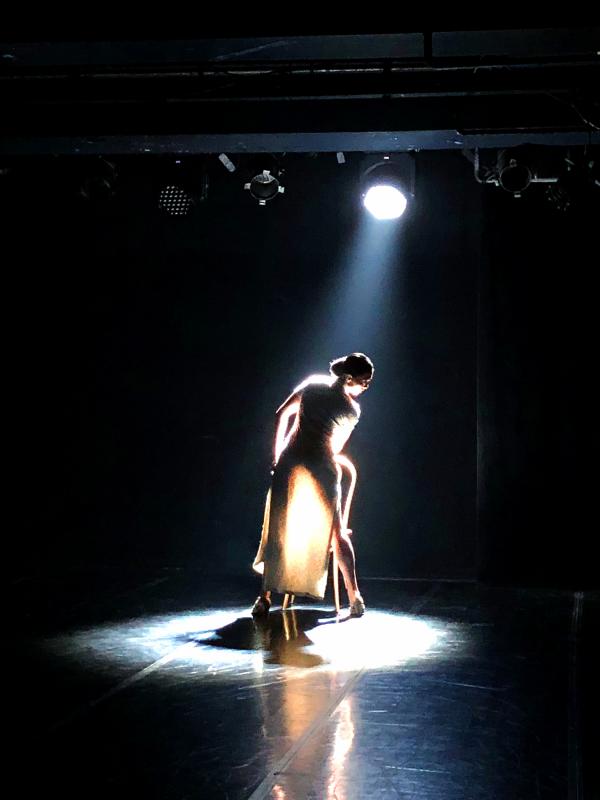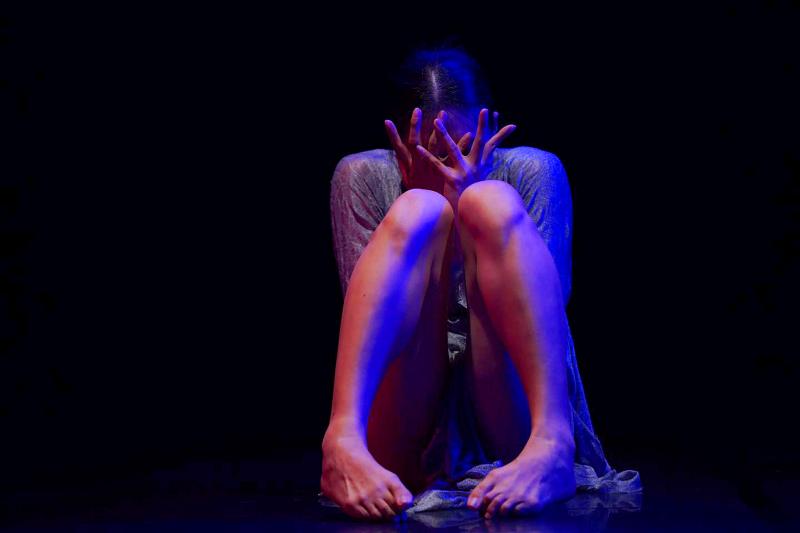To mark what would have been acclaimed Shanghai-born novelist Eileen Chang’s (張愛玲) 100th birthday at the end of this month, Taipei Dance Forum (舞蹈空間) director Ping Heng (平珩) decided to revive one of the company’s 25th anniversary works from 2014, Red and White (紅與白), but give it a more personal feel.
While the original production, created by choreographer Cheng Yi-wen (鄭伊雯) and theater director Liu Shou-yao (劉守曜), was performed at the Taipei City Shuiyuan (Wellspring) Theater, the company will be performing this weekend at its much smaller space at the Crown Cultural Center.
The updated production seats audiences much closer to the dancers, hence the new title, Red and White, zoom-in (紅與白zoom-in版).

Photo: Diane Baker, Taipei Times
Red and White used Chang’s 1944 novella The Red Rose and the White Rose (紅玫瑰與白玫瑰) for inspiration. Set in Shanghai in the 1930s, it is the story of a young man who returns to China after studying in England and has an affair with the wife of a friend. However, when the woman suggests she get a divorce so that they can wed, he ends the affair — and later marries a woman with a “virtuous” reputation.
Cheng used tango to help convey the passion of the lovers, and the torments.
As Ping said at a press preview yesterday afternoon, tango is very romantic, it comes from the heart.

Photo: Diane Baker, Taipei Times
Cheng yesterday said some of the changes she made for the new production reflect the differences in her own life from six years ago.
“The first time, I saw so many scenes straight out of the book … the images were already very clear,” she said. “But for my piece [for the company] last year I included talking, so I decided to include it again this production.”
“Allowing performers to talk makes a performance more whole, it’s not just about dance,” she said.

Photo courtesy of Hung Dance
Being married has changed her views on relationships and love, she said. When she choreographed the original version, she was single, and, she thought, very happy with her life.
“Six years ago I was very different, very calm, but now I realize that I wasn’t really. Having my daughter has taught me about real, unconditional love,” she said. “In marriage, we can’t hide our feelings, there is nowhere to run.”
“Before she was the red rose, now she is the white one,” Ping added.
Ping praised the work of stage designer Liu Da-lun (劉達倫) and lighting designer Huang Shen-chuan (黃申全) for turning the center’s black box space into a 1940s-era Shanghai nightclub, complete with a row of small tables and chairs on the edge of the dance floor.
However, Ping said she was slightly worried that audience members would not want to sit at the tables for fear of being pulled onto the dance floor.
While Taipei Dance Forum’s production is all about relationships and passion, over at the National Experimental Theater, Hung Dance (翃舞製作) is focusing more on the personal.
The company is presenting the first full-length solo work choreographed by dancer and long-term collaborator Cheng I-han (鄭伊涵), No. Me (孤獨號).
Cheng I-han, whom I first noticed several years ago in Kaohsiung City Ballet’s (高雄城市芭蕾舞團) Dance Shoe (點子鞋) productions, is a wonderful dancer, combining steely resolve with a beautifully pliant body.
She has served as a muse for several years for Hung Dance founder Lai Hung-chung (賴翃中), a fellow Taipei National University of the Arts (國立臺北藝術大學) alumnus, and her performances helped shine a spotlight on his works, and were surely key to helping him racking up a series of wins at international choreographic competitions.
In No. Me, she embarks on a voyage of exploration, of “practicing loneliness,” with her body as the ship, while utilizing lighting — by Tsai Chao-yu (蔡詔羽) — visual elements, scents and music — by Alexandre Dai Castaing — to help create the mood for her introspective journey.
“Every person who wants to practice being alone is a “‘No. me’ … but hope flows when you make every effort to believe in yourself,” the company said.
Following this weekend’s three shows, the company will take No. Me to Taichung in mid-November.
Performance notes:
WHAT: Red and White, zoom-in
WHEN: Tomorrow and Saturday at 7:30pm, Saturday and Sunday at 2:30pm
WHERE: Crown Art Center, B1, No. 50, Ln 120, Dunhua N Rd, Taipei City (台北市敦化北路120巷50)
ADMISSION: NT$800; available at NTCH and Eslite ticket offices, online at www.artsticket.com and convenience store ticketing kiosks. Tomorrow and Sunday’s shows are sold out
WHAT: No. Me
WHEN: Tonight and tomorrow at 7:45pm, Sunday at 2:45pm
WHERE: National Experimental Theater (國家實驗劇場), 21-1 Zhongshan S Rd, Taipei City (台北市中山南路21-1號)
ADMISSION: NT$700, available at NTCH and Eslite ticket offices, online at www.artsticket.com.tw and at convenience store ticketing kiosks. Friday’s show is sold out.
ADDITIONAL PERFORMANCES: Nov. 13 at 7:45pm and Nov. 14 at 2:45pm at National Taichung Theater’s (臺中國家歌劇院大劇院) Black Box Theater, No. 101 Huilai Rd, Sec. 2, Situn District, Taichung (臺中市西屯區惠來路二段101號). Tickets are NT$600, available as above or at the theater’s box office

On April 26, The Lancet published a letter from two doctors at Taichung-based China Medical University Hospital (CMUH) warning that “Taiwan’s Health Care System is on the Brink of Collapse.” The authors said that “Years of policy inaction and mismanagement of resources have led to the National Health Insurance system operating under unsustainable conditions.” The pushback was immediate. Errors in the paper were quickly identified and publicized, to discredit the authors (the hospital apologized). CNA reported that CMUH said the letter described Taiwan in 2021 as having 62 nurses per 10,000 people, when the correct number was 78 nurses per 10,000

As Donald Trump’s executive order in March led to the shuttering of Voice of America (VOA) — the global broadcaster whose roots date back to the fight against Nazi propaganda — he quickly attracted support from figures not used to aligning themselves with any US administration. Trump had ordered the US Agency for Global Media, the federal agency that funds VOA and other groups promoting independent journalism overseas, to be “eliminated to the maximum extent consistent with applicable law.” The decision suddenly halted programming in 49 languages to more than 425 million people. In Moscow, Margarita Simonyan, the hardline editor-in-chief of the

Six weeks before I embarked on a research mission in Kyoto, I was sitting alone at a bar counter in Melbourne. Next to me, a woman was bragging loudly to a friend: She, too, was heading to Kyoto, I quickly discerned. Except her trip was in four months. And she’d just pulled an all-nighter booking restaurant reservations. As I snooped on the conversation, I broke out in a sweat, panicking because I’d yet to secure a single table. Then I remembered: Eating well in Japan is absolutely not something to lose sleep over. It’s true that the best-known institutions book up faster

Though the total area of Penghu isn’t that large, exploring all of it — including its numerous outlying islands — could easily take a couple of weeks. The most remote township accessible by road from Magong City (馬公市) is Siyu (西嶼鄉), and this place alone deserves at least two days to fully appreciate. Whether it’s beaches, architecture, museums, snacks, sunrises or sunsets that attract you, Siyu has something for everyone. Though only 5km from Magong by sea, no ferry service currently exists and it must be reached by a long circuitous route around the main island of Penghu, with the